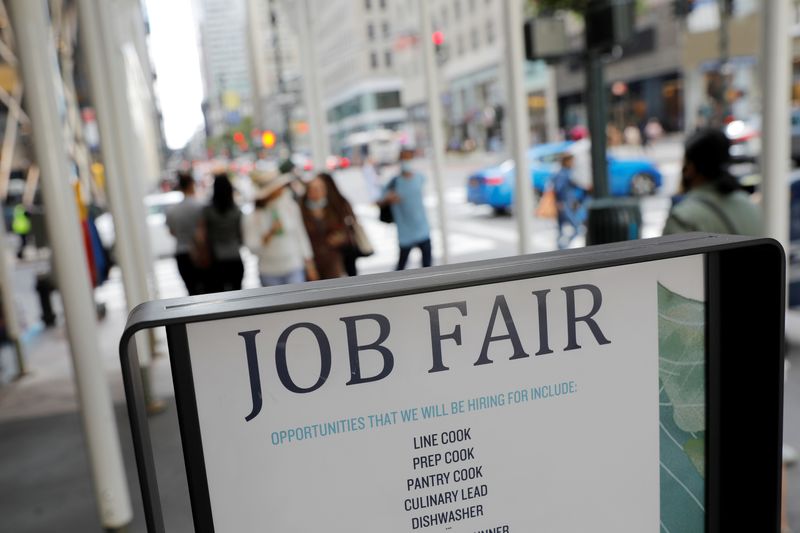US weekly jobless claims increase slightly; third-quarter GDP growth trimmed
2023.12.21 09:15

© Reuters. FILE PHOTO: Signage for a job fair is seen on 5th Avenue after the release of the jobs report in Manhattan, New York City, U.S., September 3, 2021. REUTERS/Andrew Kelly/File Photo
WASHINGTON (Reuters) – The number of Americans filing new claims for unemployment benefits rose just marginally last week, suggesting underlying strength in the economy as the year winds down.
Initial claims for state unemployment benefits increased 2,000 to a seasonally adjusted 205,000 for the week ended Dec. 16, the Labor Department said on Thursday. Economists polled by Reuters had forecast 215,000 claims for the latest week.
Though the claims data are volatile around this time of the year because of holidays, they remain consistent with a fairly healthy labor market, which is expected to keep the economy from recession next year. A survey from the Conference Board on Wednesday showed the share of consumers viewing jobs as plentiful was the highest in five months in December.
The claims data covered the week during which the government surveyed businesses for the nonfarm payrolls portion of December’s employment report. Claims rose slightly between the November and December survey periods.
The economy added 199,000 jobs in November, below the monthly average of 240,000 over the past year, but higher than the 150,000 positions created in October.
The Federal Reserve held interest rates steady last week and policymakers signaled in new economic projections that the historic monetary policy tightening engineered over the last two years is at an end and lower borrowing costs are coming in 2024. Since March 2022, the U.S. central bank has hiked its policy rate by 525 basis points to the current 5.25%-5.50% range.
Data next week on the number of people receiving benefits after an initial week of aid, a proxy for hiring, could shed more light on the labor market’s fortunes in December. The so-called continuing claims slipped 1,000 to 1.865 million during the week ending Dec. 9, the claims report showed.
Continuing claims have mostly increased since mid-September, blamed largely on difficulties adjusting the data for seasonal fluctuations after an unprecedented surge in filings for benefits early in the COVID-19 pandemic.
Economists expect the distortion will be smoothed out when the government revises the data next year. Labor market strength is fueling consumer spending, keeping the overall economy afloat. In a separate report on Thursday, the government confirmed that economic growth accelerated in the third quarter.
Gross domestic product increased at a 4.9% annualized rate last quarter, revised down from the previously reported 5.2% pace, the Commerce Department’s Bureau of Economic Analysis (BEA) said in its third estimate of third-quarter GDP.
It was still the fastest pace of expansion since the fourth quarter of 2021. Economists had expected GDP growth would be unrevised at a rate of 5.2%.
The economy, which grew at a 2.1% pace in the second quarter, has been expanding at a pace far above what Fed officials regard as the non-inflationary growth rate of around 1.8%. Momentum, however, appears to have faded in the final three months of the year as consumer spending takes a breather.
Growth is also expected to be restrained by a wider trade deficit and slower pace of inventory building relative to the third quarter.
But the growth pace likely remains enough to fend off a recession, with retail sales unexpectedly rising in November and single-family housing starts and building permits scaling 1-1/2-year highs. Growth estimates for the fourth quarter range from as low as a 1.1% rate to as high as a 2.7% pace.








